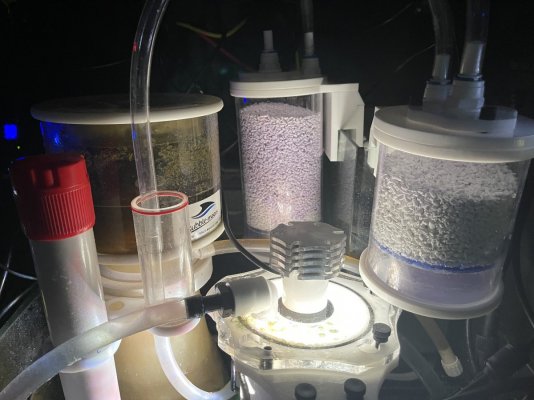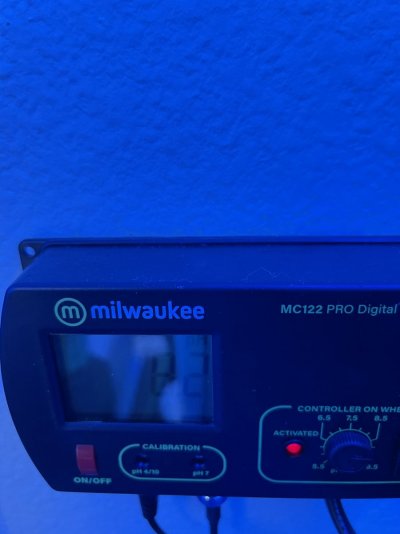For those interested in maintaining pH stability around +/- 0.05 I have a couple of lessons learned. These are things that I found out on my journey to pH stability.
- Prior to seeking pH stability my tank pH was consistently around ~7.9. However, much of this journey went on before the tank was mature with lots of photosynthetic organisms. I have no doubt that had I just waited, daytime and nighttime pH (with a refugium) would have been higher.
- It's possible to maintain pH stability around +/- 0.05. My setup is Kalkwasser, reverse light-cycle Refugium, oversized skimmer with recirculating CO2 scrubber, valve to switch between CO2 scrubbed air and indoor air, and controller.
- A continuous kalkwasser drip was most effective and provided me with a pH boost of about ~0.12
- Refugium took three tries to really get going and needs weekly trimming to maintain health and optimal benefits
- If home air is between 600-800 my pH is easy to maintain. Below 600, my pH highs can go above 0.025 of my setpoint during the day period. Above 800 my lows can go below 0.025 of my setpoint.
- An oversized skimmer was required to stabilize and control my pH (I have an Aeraqua Dou on a 100gal tank ~3X what I need). I believe this was needed to overcome the rest of the tank aeration from powerheads and return pumps.
- My skimmer is only active to raise or lower pH and comes on for about 6-8 hours a day. Despite only using my skimmer for pH control, it still skims a ton (~1000ml a week)
- Often figuring out why my pH would go out of alignment was a challenge and had me going down rabbit holes. Ultimately, it always came down to CO2 scrubber, Kalkwasses, and air CO2 levels. Typically lower lows was an indication of CO2 scrubber issue, lower average was a Kalkwasser issue, and higher highs was lower levels of air CO2 due to good weather and open windows and doors.
- Figuring out when the CO2 media is exhausted was trial and error. I eventually figured out lower lows indicated something was up with my CO2 scrubber. I'm getting roughly 1 month of CO2 scrubbing from my media (6 cups). I use the BRS DUO Jumbo CO2 Scrubber which has 2x 6-cup capacity media holders. I use this setup to maximize the life of the media. Basically monthly I take the 2nd stage cartridge and move it to the 1st stage and add a fresh cartridge to the 2nd stage. This ensures I get the maximum life by fully exhausting the media. I use a similar trick for the di phase of my RODI system.
- Recirculating air tubing can fill with condensation and impact airflow. You want to make sure your tubing doesn't have any dip to collect the water.
- Typical CO2 scrubber issues included exhausted CO2 media, clogged airline, no moisture for the media (had this before recirculation), too much water in the media cartridges (before the Jumbo setup) , issue with skimmer performance
- Typical kalkwasser issues included unsaturated kalk (measured with EC meter) due to bar stirrer (switched to a magnetic stirrer), unsaturated kalk due to much kalk in reactor not allowing the magnetic stirrer to stir or too little kalk, and issues with reservoir running dry. Also caught a tube blockage...
- Typical indoor CO2 level issues are when indoor air is low in CO2 (open windows) and I can't drive down the pH or when it's way high (lots of people or heating/cooking) and skimmer can't contribute as much. Interesting enough, when it's raining outside CO2 goes up in the house by a little bit.
- Having the skimmer after the refugium was a mistake for me (at least with chaeto). I was typically cleaning out my skimmer every 6 weeks with just an acetic bath and always found performance went up afterwards as expected. I was having unexpected lower pH lows and thought there was something going on with the CO2 scrubbing...took forever to figure out, long story short, chaeto was getting in the needle wheel. I had to switch the refugium and skimmer locations in the sump.




















